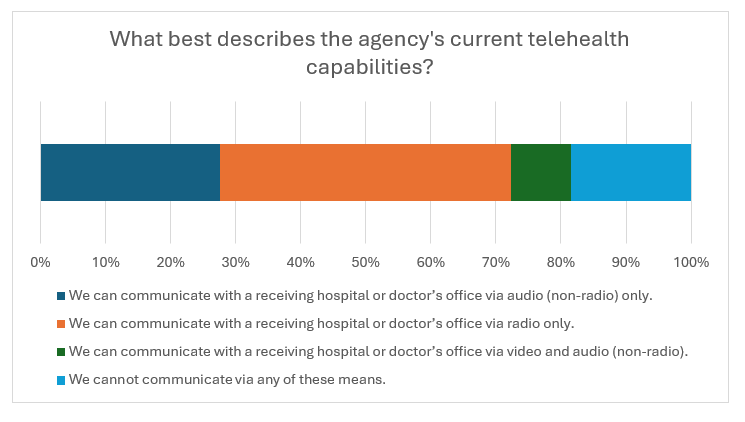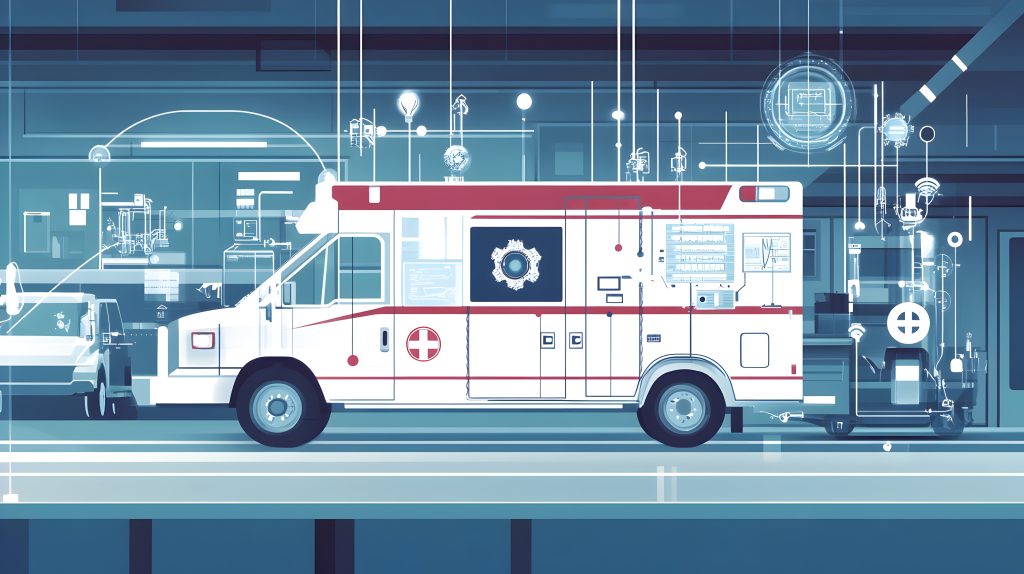Emergency Medical Services (EMS) are critical in providing timely and life-saving care to patients in emergency situations. As the health care landscape evolves, telehealth can play a vital role in expediting patient care during emergency situations. For instance, UVA Health utilizes a telestroke program that allows for real-time stroke evaluation, improving care efficiency during transport.
To better understand the current state of telehealth adoption among EMS agencies in Virginia, the Virginia Telehealth Network collaborated with the Virginia Department of Health Office of Emergency Medical Services to conduct a survey of Virginia’s EMS agencies. The survey gathered responses from 76 unique representatives of the 71 EMS agencies across the state, and 83% of respondents represented agencies licensed as Advanced Life Support (ALS) Transport.
Here are some of the key takeaways.
State of Telehealth Use Among Virginia’s EMS Agencies
Telehealth is not yet widely adopted by EMS across the Commonwealth, with many agencies facing challenges in implementing and sustaining telehealth services.
While most respondents reported an ability to communicate with a receiving hospital or doctor’s office via radio, audio (non-radio), and/or video, 18.4% reported being unable to do so via any of these means. Furthermore, only 9.2% reported being able to use video and audio (non-radio) to communicate with hospitals or doctor’s offices.
Priorities and an Interest in Telehealth
Nearly 40% of respondents’ agencies reported they are interested in establishing or expanding an existing telehealth program, while about a third (30%) are not currently interested but may consider it in the future.
“Our agency would be very interested in participating in telehealth for various reasons. A priority of expediency in appropriate care and destination determination would be our first objective. From there, helping allow for medical evaluations with alternate pathways for appropriate care would be a next step,” noted one respondent.
Respondents also reported various forms of telehealth as being within their agencies’ priorities. On a scale of 1 to 5, with 5 being highest priority, respondents said:
- Clinical supervision was the highest rated priority (3.0)
- Video provider-to-provider (EMS to hospital or doctor) (2.7)
- Remote patient monitoring (2.5)
Another respondent said, “I believe it would be beneficial for video-to-video communication for patients that need aggressive prehospital treatment in the field. This will help providers have a second set of eyes in the field that can provide input to be able to provide the quickest and most efficient care possible. This would be especially beneficial for agencies that have extended transport times and helicopter transport is not available either.”
Challenges and Needs
Survey findings identified challenges that hinder the adoption of telehealth by EMS agencies. A lack of telehealth infrastructure/connectivity and limited financial resources were identified as the limiting factors of greatest concern to agencies’ ability to provide telehealth services.
Respondents also provided suggestions for the Commonwealth regarding provision of telehealth services, including:
- Forum for EMS agencies to “get on the same page”
- Statewide infrastructure, including resources and training
- Statewide telehealth resource center staffed by physicians and NPs
- Focus on connectivity improvements, particularly for rural areas
- Clear regulatory/legal guidance for appropriate role of EMS agencies
“There needs to be ways to fund this program so that agencies would not lose the financial aspect of transporting patients to local EDs. In the same sense though, this would clear some of the congestion at local EDs from patients that don’t necessarily need to be at the ED but could be handled by a telehealth visit instead and a doctor calling in prescriptions for common illnesses,” a respondent said.
One respondent also noted a need for funding in EMS programs, “so that agencies won’t lose the financial aspect of transporting patients to local EDs.”
These survey results will help inform future enhancements to Virginia’s State Telehealth Plan and guide efforts to improve telehealth adoption and sustainability in EMS agencies. By addressing the challenges and limitations identified in the survey, we can enhance the quality and accessibility of emergency medical services in Virginia.

